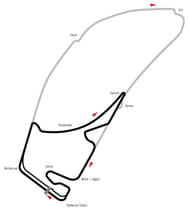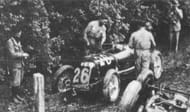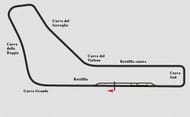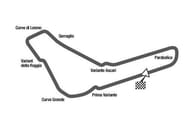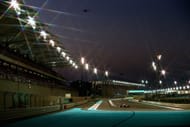New Layout
Thus, the track was redesigned yet again in 2002, to its current format. This was a drastic change from previous versions. It completely avoided the forest section. The area enclosed by the circuit was reduced by half, and a totally new middle section was added. The map below shows both the forms.
The current circuit measures 4.5km in length. Kimi Raikkonen’s McLaren holds the lap record (1:13.780 in 2004).
This new circuit avoids the long straights through the dense forests, but still retains a pull as a high speed track. The start finish straight, the straight after turn 1, the hairpin and Sachs corner are the places to overtake. During the redesign, the stadium section was the only part of the track that was left untouched.
Despite the changes, the new version has drawn mixed responses.
Monza
Old Layout
The 10km long track was officially opened in 1922, and held its first race in that year. Like most of the old Formula One circuits, Monza is famous for its long straights and hence gets its nickname – “The temple of speed”.
Monza has claimed the lives of many drivers in the past, and maybe, the most horrific accident was that of Emilio Materassi in 1928. The crash even resulted in the death of more than 25 spectators.
In 1933, Monza claimed the lives of three more drivers – Giuseppe Campari, Mario Umberto Borzacchini and Count Stanislas Czaykowski. All lost their lives at the same sector, the south banking of the track. This put the death toll at Monza to nine in its 11 years of existence, leading to a rethink.
An alternative circuit, named Florio, was used from 1935 to 1937. Only one half of the oval segment was used, and a chicane was added in its course. The distinct feature of this layout was the addition of two 90 degree turns to switch between the two parts, entering the oval from the Rettifilo Centrale straight. The idea was to use this circuit while a new one was being built. The altered circuit hosted a race from 1938 up to 1954, with the exception of the war years.
Monza has been on the F1 calendar every year since 1955. The circuit used for the 1955 race was a combination of the high speed road section, and the oval section. This recreated the 10km racetrack of the old Monza.
As soon as the oval returned, the track claimed another victim – Wolfgang von Tips. The Dutchman’s car was sent flying into the stands after a collision with Jim Clark at Parabolica.
Following concerns over the banking, dangerous speeds and bumps along the road, the oval section was deemed too unsafe for F1. It was used for the last time in Formula One in the year 1969. A decision was made to replace the oval with a new road circuit, with a wider road, and with new safety barriers and fences.
The 1971 race was the last Italian Grand Prix held without chicanes. In 1972, a chicane was added at the end of the start finish straight before Rettifilo, and another one at Curva del Vialone. This was done owing to newer technology – speeds were increasing and the flat out sections had become unsafe for racing.
Minor changes, like the construction and expansion of stands, making larger kerbs, and improvement of pit-lane capacity continued till 1978.
New Layout
In the 1990s, the chicane at the end of the start finish straight was changed from right-left to left-right, with a gravel trap. A run-off area replaced the gravel in 2007, to form the current layout. The lap measures 5.8km in distance. Overtaking is usually done along the back straight leading to Parabolica, along the start finish straight, along Curva Grande, and approaching Della Roggia. Straight line speed holds the key here.
The Monza circuit has been redeveloped over the years on almost the same patch of land (consisting of the high-speed road section and the steeply banked oval section), unlike the two German circuits which delved into forests. Apart from Formula One, Monza also hosts vintage car and motorcycle events.
Other tracks
All the historic Formula One racetracks on the calendar have seen major modifications over the years – the Hungaroring, the Spa Francorchamps and Imola, for example. Even the Monaco Grand Prix hasn’t been spared of change despite the unique challenge it offers.
Among all, Monza, Nurburgring and Hockenheim are the ones that I feel have the richest history, the ones worth some extra attention. That said, the new and modern circuits like the ones in Abu Dhabi, Texas and Shanghai are believed to be equally challenging for both drivers and engineers.
In Abu Dhabi, temperature and humidity pose the biggest challenge, while in Texas, the challenges are terrain differences and the tight corners. In case of Shanghai, it is a toss between setting up the car for best performance down the long back straight, or gaining time from the slow sector 2 and the long sweeping right handers.
With the administrators looking at new tracks every year, and concentrating more than ever on safety, even these tracks will have to change over time to stay in contention. This means that some of the existing ones might even have to go out of the calendar.
There were reports of Bernie considering the future of Monza after 2016. I understand that the sport has to move on, that the new tracks can fetch more bucks, but can they provide the old-world charm of tracks like Monza? Will they have scope for modifications in the minor area that they may be built upon? Only time will tell.
One thing is for certain though. F1 or no F1, tracks like the Nurburgring, Hockenheim and Monza are well entrenched in the history of Formula One. Whatever happens, they will forever hold a special place in the hearts of drivers and spectators alike.
